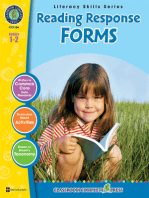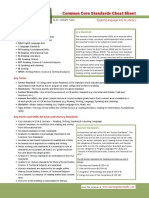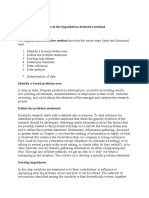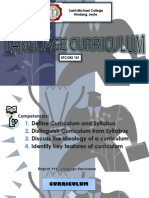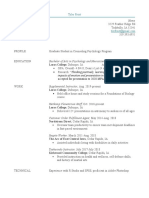0 ratings0% found this document useful (0 votes)
115 viewsWritinglesson
Writinglesson
Uploaded by
api-253646290Copyright:
© All Rights Reserved
Available Formats
Download as DOCX, PDF, TXT or read online from Scribd
Writinglesson
Writinglesson
Uploaded by
api-2536462900 ratings0% found this document useful (0 votes)
115 views5 pagesOriginal Title
writinglesson
Copyright
© © All Rights Reserved
Available Formats
DOCX, PDF, TXT or read online from Scribd
Share this document
Did you find this document useful?
Is this content inappropriate?
Copyright:
© All Rights Reserved
Available Formats
Download as DOCX, PDF, TXT or read online from Scribd
Download as docx, pdf, or txt
0 ratings0% found this document useful (0 votes)
115 views5 pagesWritinglesson
Writinglesson
Uploaded by
api-253646290Copyright:
© All Rights Reserved
Available Formats
Download as DOCX, PDF, TXT or read online from Scribd
Download as docx, pdf, or txt
You are on page 1of 5
LESSON PLANNING FORM Name: Briana Lucas
Grade level: Intermediate Level
Writing Lesson
Observation: 1 2 3 4
1. Title of Lesson: Stressing of Words (Syllables)
2. Long-Time Goal: Students will be able to:
Express personal opinions and preferences
Acknowledge individual differences
Share life experiences
To use various organization skills
3. Standards addressed: New York ESL Standards- Intermediate 5-8
Standard 1: Students will listen, speak, read, and write in English for information and understanding.
o Read, gather, view, listen to, organize, discuss, interpret, and analyze information related to academic content areas from various
sources
o Formulate, ask, and respond to various question forms to obtain, clarify, and extend information and meaning
o Make and support inferences about information and ideas with reference to features in oral and written text.
o Use the process of prewriting, drafting, revising, peer editing, and proofreading to produce well-constructed information texts.
Standard 2: Students will listen, speak, read, and write in English for literary response, enjoyment, and expression.
o Read, listen to, view, write about, and discuss texts and performances from a wide range of authors, subjects, and genres.
o Locate and identify selected literary elements and techniques in texts and relate those elements to those in other works and to
students own experiences.
o Compose and present personal and formal responses to and interpretations of published literary works and the work of peers,
referring to details and features of text.
o Create stories, poems, songs, and plays, including those that reflect traditional and popular American culture, observing the
conventions of the genre; create an effective voice, using a variety of writing styles appropriate to different audiences, purposes, and
settings
4. Background of the Lesson: New York ESL Standards Intermediate 5-8: Students have already discussed and shared quick stories about their
journey to America and their daily lives. They have been introduced to various forms of writing; writing in an email, writing sentences with
subject/verb agreement, and etc. Now students will explore a different type of writing form in writing a Haiku Poem.
5. Lesson Procedure page _________
Time Activities
(Divide this into sections. Sections might include: Set-up,
Introduction, Teacher-guided instruction, Individual Practice,
Group Work, Sharing Ideas, Summary, etc.)
Dialogue
(Teachers Questions; Anticipated Student
Responses)
Environment
(Materials, Strategies,
Adaptations)
Accommodations
~ 45 min Pre-Stage: Introduction
-What does your day begin?
Have a discussion about students daily life and
their personal feelings about their life.
-Can students describe their day? Can students
give a sequential layout of their day? Can they use
descriptive words?
Practice Syllables and the stressing of words
Activity
-What is a syllable? Can student tell you how
many syllables are in a word when asked?
-With the use of rubber bands, clapping of hands,
or other tactics to help students with finding the
stressing point of the words
-Discuss some of the words that were used to
describe students daily lives and write them
down. With the select words, practice finding the
syllable that is stressed (this helps with
pronouncing words correctly)
-Continue to repeat the process until students feel
comfortable with the task
Activity: What is a Haiku Poem? What
-Show examples of Haiku Poems
-Begin writing an original Haiku poem
-How do you start your day? What
events do you try to conquer when
beginning your day? Describe your
day? Use adjectives: long, boring,
exciting, difficult
-With the descriptions and words that
we just used to describe our daily
lives, lets practice pronouncing
words and stressing syllables.
-Some said that their daily routines
were interesting. Lets practice
finding the stress point in this word:
in-te-rest-ing. Use the rubber bands or
clapping of hands to break the word
up and find the stressing point
-A Haiku poem
-A haiku poem is a poem that consists
of three lines of five syllables, seven
syllables, and five syllables
-After reviewing syllables, daily life
routines, students can begin writing a
Haiku poem on their own.
-The poems should best express their
Paper, writing utensils,
examples of Haiku poem,
rubber bands
http://www.poemhunter.c
om/poems/haiku/
-print out samples of
haiku poems from this
website or other website
or source that teacher
finds
-For rubber bands,
clapping of the
hands, or other
techniques could be
used
-If students are not
able to write (for
whatever reason),
typing the poem or
reciting the poem
could be done
Post-Stage: At the end of the lesson, students
should be able to express their routines in their
daily life through poem form.
feelings about their daily life. The
poem could be funny, serious, and
informational.
6. Evaluation:
(How will you know whether or not you have achieved your goals? What did the childrens responses to this lesson tell you about whether your goals were met?)
7. Post Lesson Reflection:
What would you change about this
lesson and why would those changes
improve it?
How did your organization and
materials affect the success of the
lesson?
What were some challenges with this
lesson? What surprised you?
Additional comments?
You might also like
- Edtpa Lesson Plan 1Document4 pagesEdtpa Lesson Plan 1api-532598438No ratings yet
- Monkeys PawDocument4 pagesMonkeys PawKaitlin HartmanNo ratings yet
- Respiratorysystem-Lesson PlanDocument5 pagesRespiratorysystem-Lesson Planapi-250802146100% (2)
- Writing Up Quantitative Research in The Social and Behavioral Sciences (2016) by Marianne FallonDocument170 pagesWriting Up Quantitative Research in The Social and Behavioral Sciences (2016) by Marianne Fallonkannan_r02100% (1)
- Labour Relations in South AfricaDocument2 pagesLabour Relations in South AfricaAbongile PhinyanaNo ratings yet
- Golden Rule Schools, Inc. 2 Grade Elar Lesson Plans Week 1Document3 pagesGolden Rule Schools, Inc. 2 Grade Elar Lesson Plans Week 1Constance Hildreth DouglasNo ratings yet
- Reading Writing Connection ch1Document44 pagesReading Writing Connection ch1Bella StudenteNo ratings yet
- Glencoe Reader's Choice Unit 1 Lesson PlansDocument14 pagesGlencoe Reader's Choice Unit 1 Lesson PlansDawid FourieNo ratings yet
- Phonics For The LoraxDocument2 pagesPhonics For The Loraxlaurensr318No ratings yet
- Lesson Plans For Week Long Literacy BlockDocument10 pagesLesson Plans For Week Long Literacy Blockapi-3031259470% (1)
- Informational Text Toolkit: Research-based Strategies for the Common Core StandardsFrom EverandInformational Text Toolkit: Research-based Strategies for the Common Core StandardsNo ratings yet
- 10 Fabulous Ways To Teach New WordsDocument3 pages10 Fabulous Ways To Teach New WordskangsulimanNo ratings yet
- May Reading ResponseDocument1 pageMay Reading Responseapi-204472461No ratings yet
- A Pathway To Effective Writing Module 2Document10 pagesA Pathway To Effective Writing Module 2Mara Beatriz IbarraNo ratings yet
- British Literature and Composition Course SyllabusDocument4 pagesBritish Literature and Composition Course Syllabusapi-384445150No ratings yet
- Parts of Speech TableDocument3 pagesParts of Speech TableTan Lopez50% (2)
- Greek and Latin Roots Lesson PlanDocument4 pagesGreek and Latin Roots Lesson Planapi-271048453No ratings yet
- Gr6 CalvinandHobbes (1) PowerPointDocument20 pagesGr6 CalvinandHobbes (1) PowerPointDan SNo ratings yet
- Six TraitsDocument25 pagesSix TraitsKatherine Meneses100% (2)
- English Paper 3 (Listening) Tips and Skills HANDOUTDocument26 pagesEnglish Paper 3 (Listening) Tips and Skills HANDOUTMATTHEW LAMNo ratings yet
- LiteracyEssentials StudyGuidev4-REVDocument12 pagesLiteracyEssentials StudyGuidev4-REVParviz YousefiNo ratings yet
- Personal Narrative Writing AssignmentDocument6 pagesPersonal Narrative Writing AssignmentBernadette BernsteinNo ratings yet
- 7th Grade English Language Arts ChecklistDocument4 pages7th Grade English Language Arts ChecklistSanaj M ShajiNo ratings yet
- K-1 Writing FolderDocument39 pagesK-1 Writing FolderCharm GaculaNo ratings yet
- Glencoe Reader's Choice Unit 6 Lesson PlansDocument31 pagesGlencoe Reader's Choice Unit 6 Lesson PlansDawid FourieNo ratings yet
- Efficient Reading SkillsDocument12 pagesEfficient Reading SkillskiranNo ratings yet
- Objectives: Author's Purpose Lesson Plan "Why Did They Write That?"Document5 pagesObjectives: Author's Purpose Lesson Plan "Why Did They Write That?"Jessica PulidoNo ratings yet
- Diary of A Wmpy Kid - Rodrick RulesDocument12 pagesDiary of A Wmpy Kid - Rodrick RulesEmilio Paolo ConsultaNo ratings yet
- Annotating Text Sheet 1Document2 pagesAnnotating Text Sheet 1api-295309142100% (1)
- Nonfiction Writing ChecklistDocument1 pageNonfiction Writing Checklistapi-350957793No ratings yet
- Sentence ClauseDocument5 pagesSentence ClauseOsama Bin AmerNo ratings yet
- Salutsky-Intro To Creative Writing SyllabusDocument3 pagesSalutsky-Intro To Creative Writing Syllabusapi-242185334No ratings yet
- Writing Language and Content ObjectivesDocument18 pagesWriting Language and Content ObjectivesDeo Quimpo QuinicioNo ratings yet
- Simile Lesson Plan 2nd GradeDocument5 pagesSimile Lesson Plan 2nd Gradeapi-455196654No ratings yet
- Reading MasteryDocument4 pagesReading MasteryAyu Fitria IkhsaniNo ratings yet
- 6th Grade Ela Syllabus - 2018-2019Document5 pages6th Grade Ela Syllabus - 2018-2019api-248985675No ratings yet
- Ela 5Document3 pagesEla 5api-402114627No ratings yet
- Inferences Lesson PlanDocument5 pagesInferences Lesson Planapi-278575881No ratings yet
- Reading HomeworkDocument2 pagesReading Homeworkapi-205822143No ratings yet
- Year 7: English: Term 1 Learning Journey: Convince Me! Persuasive Speech UnitDocument12 pagesYear 7: English: Term 1 Learning Journey: Convince Me! Persuasive Speech Unitlisarudd93No ratings yet
- Gr. 4 OpinionDocument11 pagesGr. 4 OpinionHeidi MekkyNo ratings yet
- Figurative Language PacketDocument11 pagesFigurative Language Packetdcspada100% (1)
- 7th ELA Module 4aDocument9 pages7th ELA Module 4aVirgilio Rosario BiagtanNo ratings yet
- 9th Grade English Unit 9 1 First WeekDocument59 pages9th Grade English Unit 9 1 First Weekapi-236114585100% (1)
- Writing First HandoutDocument16 pagesWriting First HandoutMystie Rail75% (4)
- Hamburger Paragraph LessonDocument5 pagesHamburger Paragraph Lessonapi-351696919No ratings yet
- STAR English-LanguageArts Grade04 2009Document73 pagesSTAR English-LanguageArts Grade04 2009ilovepdfNo ratings yet
- Close ReadingDocument6 pagesClose Readingapi-291467690No ratings yet
- English Language Arts Curriculum StandardsDocument93 pagesEnglish Language Arts Curriculum StandardsxjoerenoxNo ratings yet
- Elhamkg 1Document154 pagesElhamkg 1princess27SNo ratings yet
- GrammerDocument11 pagesGrammerzayarmyint_uNo ratings yet
- 英文三段題本Document18 pages英文三段題本Rei JhangNo ratings yet
- Literacy PlannerDocument11 pagesLiteracy PlannerDiana BergeonNo ratings yet
- Assessment of Learning - Short StoryDocument3 pagesAssessment of Learning - Short Storyapi-296751784No ratings yet
- SyllabicationDocument4 pagesSyllabicationapi-3820232100% (3)
- 2017 Released Items Ela g6Document60 pages2017 Released Items Ela g6MaryNo ratings yet
- Common Core Cheat Sheet Learning UnlimitedDocument1 pageCommon Core Cheat Sheet Learning Unlimitedapi-182083489No ratings yet
- SRSD Hooks Lesson WordDocument3 pagesSRSD Hooks Lesson Wordapi-358126166No ratings yet
- K12 Icademy Lower Middle Upper Course Catalog May2012 PDFDocument94 pagesK12 Icademy Lower Middle Upper Course Catalog May2012 PDFAnthony Coronado Quisao100% (1)
- Student Teaching Ela LP HyperboleDocument4 pagesStudent Teaching Ela LP Hyperboleapi-264021425No ratings yet
- Reading and Comprehension in the African Context: A Cognitive EnquiryFrom EverandReading and Comprehension in the African Context: A Cognitive EnquiryNo ratings yet
- Discussion Reflection LogDocument1 pageDiscussion Reflection Logapi-253646290No ratings yet
- KWL ChartDocument1 pageKWL Chartapi-253646290No ratings yet
- Lessonplan Grammar Handouts YeonjiDocument4 pagesLessonplan Grammar Handouts Yeonjiapi-253646290No ratings yet
- CT Ym Portfolio LPDocument6 pagesCT Ym Portfolio LPapi-253646290No ratings yet
- ReadinglessonDocument7 pagesReadinglessonapi-253646290No ratings yet
- ReadingscriptDocument1 pageReadingscriptapi-253646290No ratings yet
- Content LayoutDocument2 pagesContent Layoutapi-253646290No ratings yet
- Cambridge IGCSE ™: French 0520/42 October/November 2022Document12 pagesCambridge IGCSE ™: French 0520/42 October/November 2022riddhima kapoorNo ratings yet
- 1Document121 pages1Alvin RodolfoNo ratings yet
- Dissertation TagalogDocument8 pagesDissertation TagalogWriteMyNursingPaperSingapore100% (1)
- Basic Calculus PDFDocument39 pagesBasic Calculus PDFRonel CahayagNo ratings yet
- Individual Daily Log Accomplishment ReportDocument3 pagesIndividual Daily Log Accomplishment ReportLeslie PerezNo ratings yet
- Baguma VictorDocument44 pagesBaguma VictorSiifyoom HarmeeNo ratings yet
- The Seven-Step Process in The Hypothetico-Deductive MethodDocument3 pagesThe Seven-Step Process in The Hypothetico-Deductive MethodALI KHANNo ratings yet
- Time Table June2021 (SECOND COPY)Document4 pagesTime Table June2021 (SECOND COPY)shreyasharma23858No ratings yet
- Business SustainabilityDocument8 pagesBusiness Sustainabilitydgfu7364No ratings yet
- "NEW" SOCIAL STUDIES HOPE TO ACHIEVE Lesson 3Document30 pages"NEW" SOCIAL STUDIES HOPE TO ACHIEVE Lesson 3Rosmie Jane CantongNo ratings yet
- IoT PDFDocument10 pagesIoT PDFhunajeatmalingNo ratings yet
- Beirut - Lebanon: (+9613) 667124 - 131600Document2 pagesBeirut - Lebanon: (+9613) 667124 - 131600session hijackingNo ratings yet
- Saint Michael College Hindang, LeyteDocument87 pagesSaint Michael College Hindang, LeyteLC Abanggan TanNo ratings yet
- Video Production SyllabusDocument4 pagesVideo Production SyllabusDave Fontejon100% (1)
- Campus Home: Tyler FrostDocument1 pageCampus Home: Tyler Frostapi-534357044No ratings yet
- Brigada Eskwela 2019 Sample Opening Program V2Document1 pageBrigada Eskwela 2019 Sample Opening Program V2Leopold LasetNo ratings yet
- 2013 Desco Brochure PDFDocument27 pages2013 Desco Brochure PDFChaudhary MobinNo ratings yet
- ELS-DLP Q2-Unifying Themes in The Study of LifeDocument6 pagesELS-DLP Q2-Unifying Themes in The Study of LifeIrish John GulmaticoNo ratings yet
- Teaching Lessons To Children With Special Needs: by Nafme Member Brian Wagner-YeungDocument11 pagesTeaching Lessons To Children With Special Needs: by Nafme Member Brian Wagner-YeungKennyben GallogoNo ratings yet
- Gold Advanced Unit 13 Test: Name: - ClassDocument2 pagesGold Advanced Unit 13 Test: Name: - ClassАлександра ПотаповаNo ratings yet
- Parent Newsletter - LH 9 18 17Document2 pagesParent Newsletter - LH 9 18 17api-376936481No ratings yet
- Organizing Business Case Competition-Guidelines For Business SchoolsDocument19 pagesOrganizing Business Case Competition-Guidelines For Business SchoolsZamilur Rahman ShuvoNo ratings yet
- PHL Ad 17 01 Operationalguidance 2017 Eng Ops Manual Adolescent Health Development ProgramDocument111 pagesPHL Ad 17 01 Operationalguidance 2017 Eng Ops Manual Adolescent Health Development ProgramJoanne G Haw GetidaNo ratings yet
- Anglais Pour Débutants 1: Eana0Document197 pagesAnglais Pour Débutants 1: Eana0docteurgynecoNo ratings yet
- The Proficiency Level of The Reading ComDocument42 pagesThe Proficiency Level of The Reading ComcrmsncrseNo ratings yet
- Adult Literacy Games PDFDocument28 pagesAdult Literacy Games PDFAdesti KomalasariNo ratings yet
- Melange ReportDocument1 pageMelange Reportvyankatesh visputeNo ratings yet










